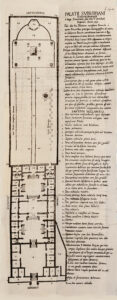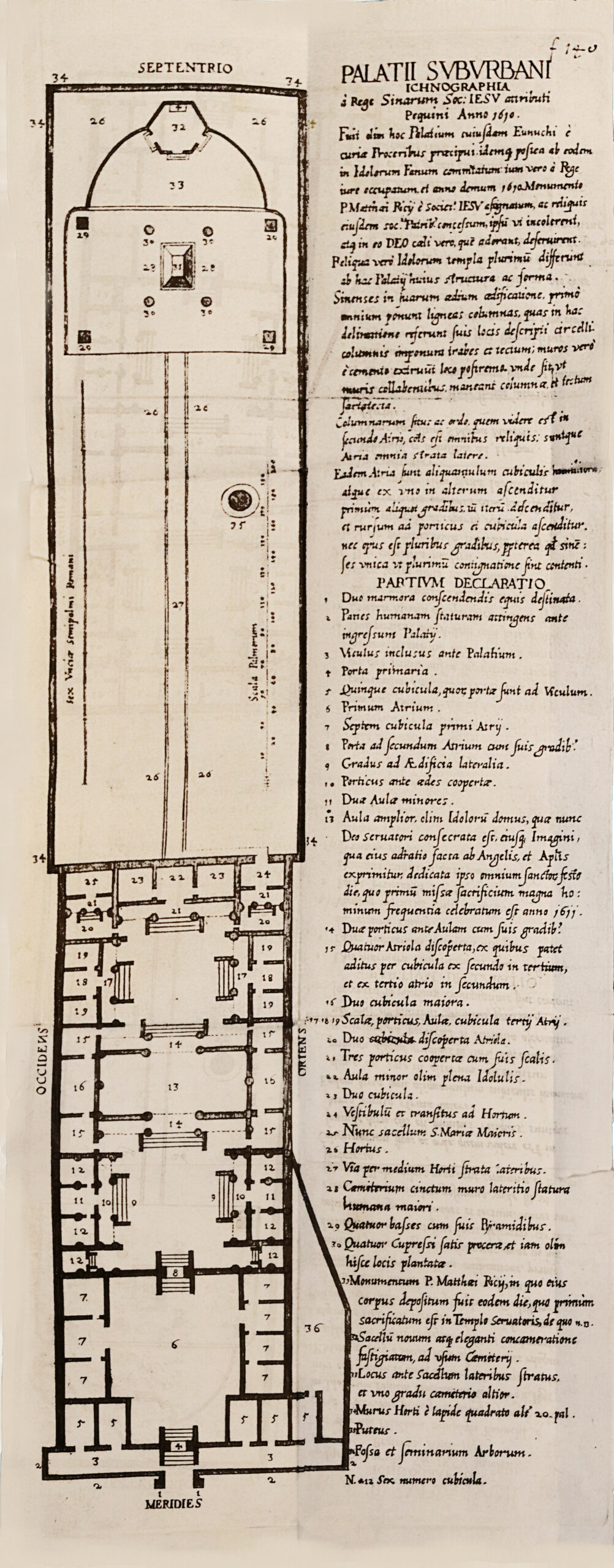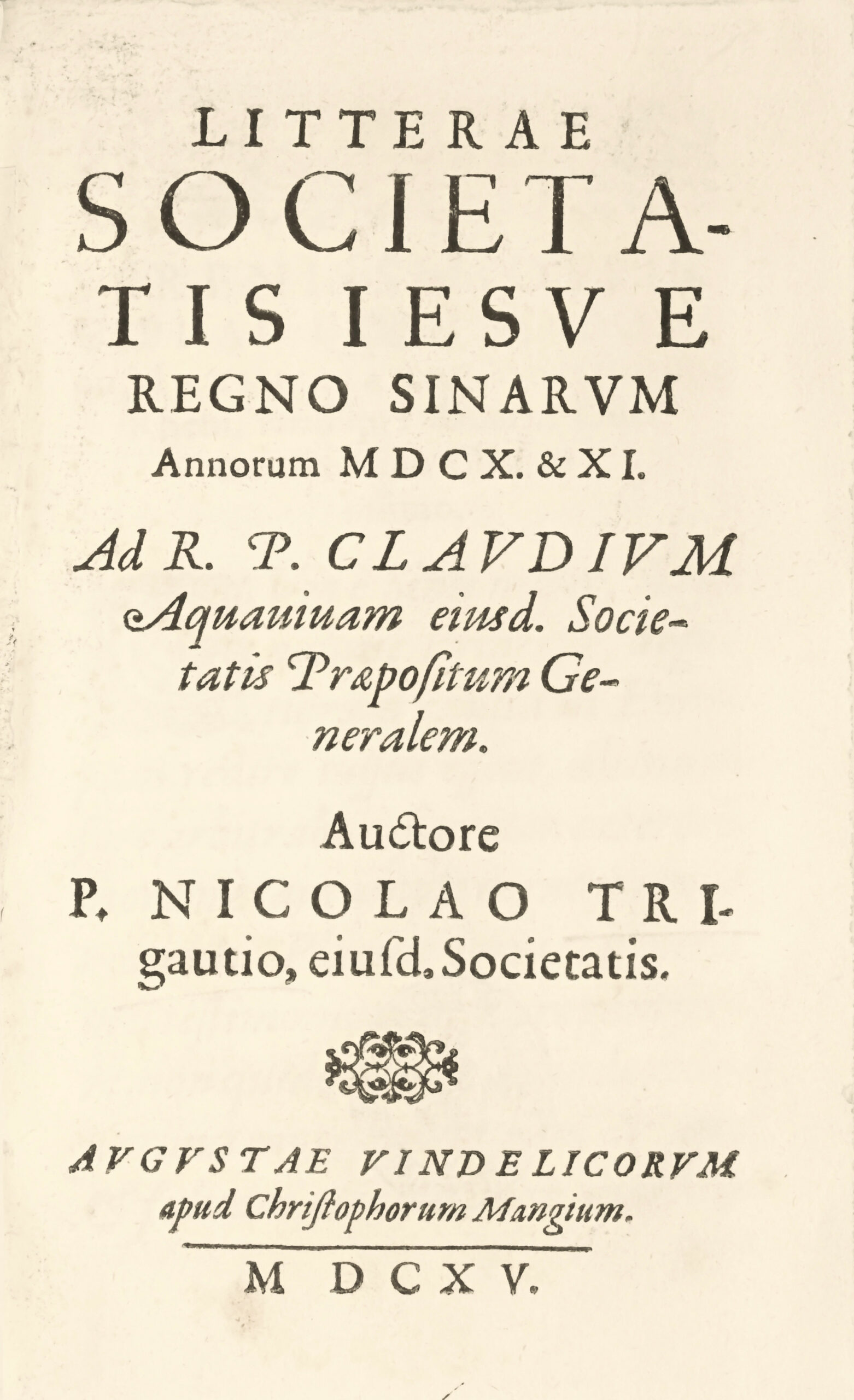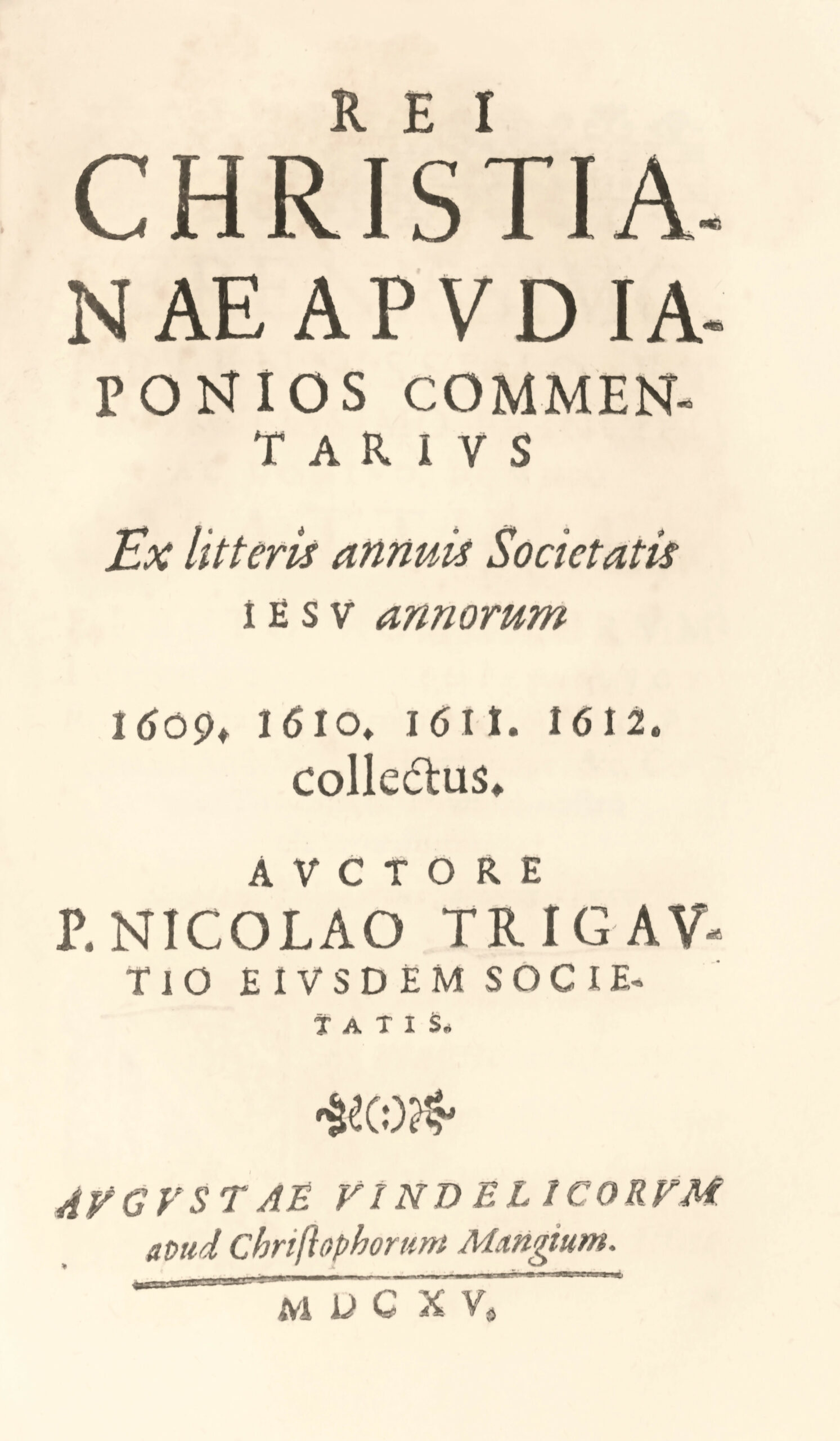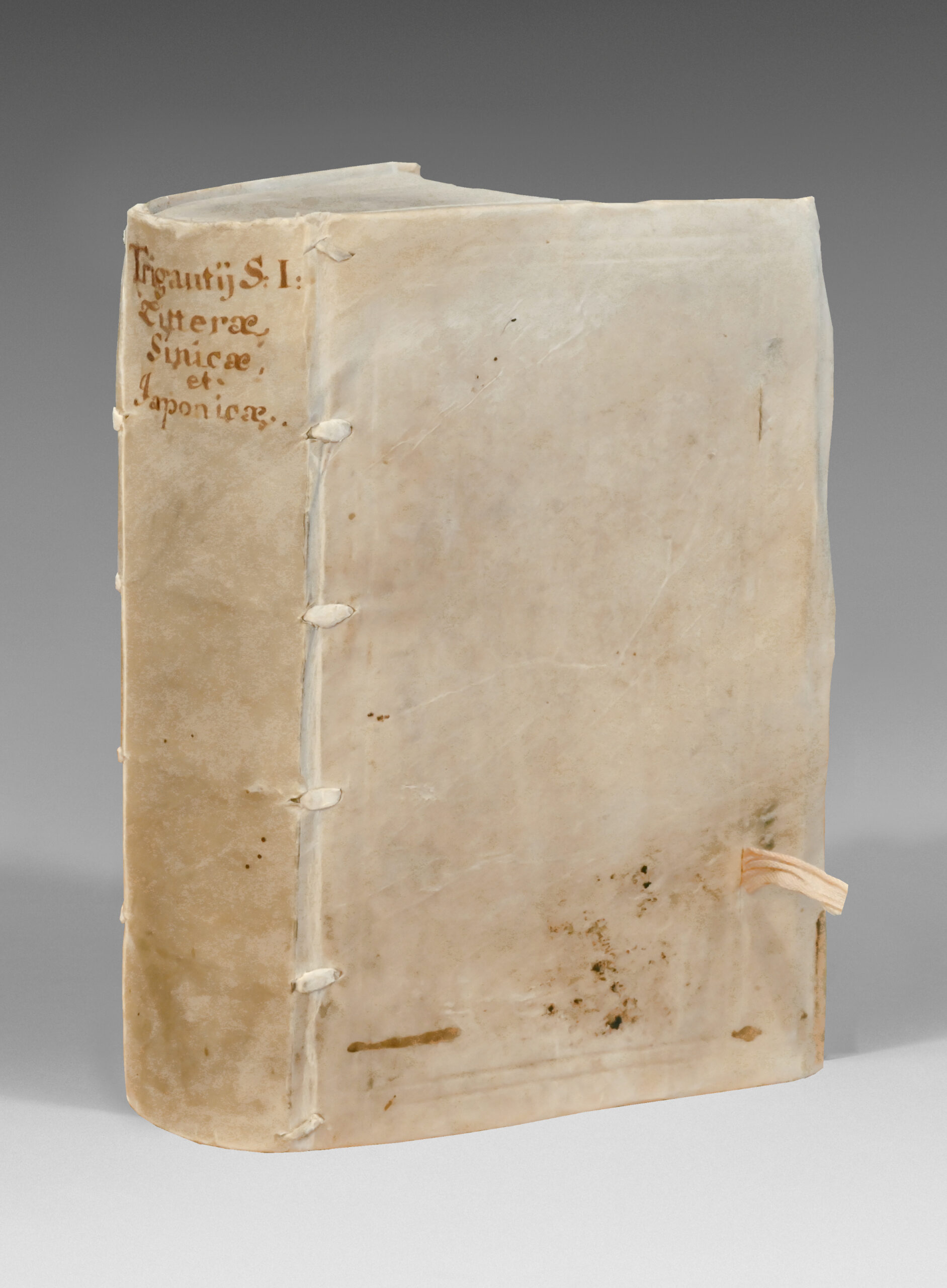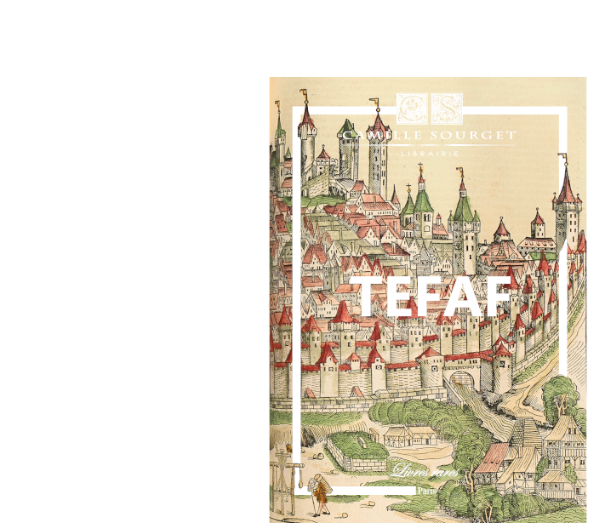Litterae Societatis Iesu e regno sinarum Annorum MDCX & XI…
Augsburg, Christoph Mangius, 1615.
– [Relié avec] : Rei Christianae apudiaponios commentaries Ex litteris annuis Societatis Iesu annorum 1609, 1610, 1611, 1612…
Augsburg, Christoph Mangius, 1615.
In-12 de : I/ (4) ff., 294 pp., (1) f.bl., 1 plan dépliant ; II/ (6) ff., (2) ff. bl., 298 pp. mal chiffrées 296, (1) f., cachet de bibliothèque au verso du titre.
Vélin rigide, restes de lanières, dos lisse avec le titre manuscrit, tranches bleutées. Reliure de l’époque.
155 x 94 mm.
I/ Rare seconde édition latine des « Deux Lettres de la Chine de 1610 et 1611 » par le missionnaire Nicolas Trigault (1557-1628) sur son voyage en Chine, complément indispensable à son « De Christiana expeditione apud Sinus » dont l’édition originale parut à Augsbourg cette même année 1615.
Cordier BS 808 ; Löwendahl 56 ; Morrisson, II, 466 ; Sommervogel VIII, col. 238.
L’édition originale avait paru en italien en 1615, et la première latine en 1615 à Anvers (avec une approbation datée Anvers, 2 mai 1615). Cette dernière fut suivie de très près par la seconde édition latine, qui porte une approbation du 25 juillet 1615.
Ce dernier livre constitue l’une des premières descriptions approfondies de la Chine dont toute la première partie est consacrée à la géographie, l’organisation politique, l’éducation, au commerce, etc. Les quatre autres parties sont dévolues, chacune, aux différentes villes.
Cet ouvrage capital connut un succès remarquable suscitant rééditions et traductions : il donna une impulsion décisive aux études sinologiques.
“The appearance of Trigault’s book in 1615 took Europe by surprise. It reopened the door to China, which was first opened by Marco Polo, three centuries before (…), opened a new era of Chinese-European relations and gave us one of the greatest, if not the greatest, missionary document in the world (…). It probably had more effect on the literary and scientific, the philosophical and the religious phases of life in Europe than any other historical volume of the seventeenth century. It introduced Confucius to Europe and Euclid to China. It opened a new world.” (Louis J. Gallagner. préface à China in the Sixteenth Century: The Journal of Matthew Ricci, New-York, 1953).
Trigault rejoignit la mission jésuite en Chine en 1610. A son retour en Europe en 1613, il fit publier ces deux lettres « della Cina del 1610 e del 1611 ». Ecrites à la demande de son supérieur, ces deux lettres décrivent “the need to respect Chinese ways of dealing with foreigners, the contrast between the peace and order in China and the turbulence in Japan, and the desirability of making China into an independent province of the Society” (Lach).
Nicolas Trigault naquit à Douai en 1577 et se disposa, par l’étude des sciences et des langues orientales, à la carrière des missions. Il se rendit en 1606, à Lisbonne, et en attendant le départ du bâtiment qui devait le transporter aux Indes, il traça le portrait du parfait missionnaire dans la vie du P. Gasp. Barzis, l’un des compagnons de Saint François Xavier. S’étant embarqué le 5 février 1607, il arriva le 10 octobre suivant à Goa. La délicatesse de sa santé, que la mer avait encore affaiblie, l’obligea de s’arrêter dans cette ville. Il n’en partit qu’en 1610 pour Macao, d’où il aborda enfin la Chine. Chaque jour les missionnaires faisaient de nouveaux progrès dans ce vaste empire. Le désir d’étendre de plus en plus leurs conquêtes les avait conduits dans les provinces les plus éloignées, où ils comptaient de nombreux prosélytes : aussi devenait-il indispensable d’augmenter le nombre de ces ouvriers évangéliques. Le P. Trigault fut choisi pour revenir en Europe y rendre compte de l’état et des besoins des missions de la Chine. Arrivé dans l’Inde il jugea convenable de poursuivre son voyage par terre et, chargé d’un sac de cuir qui renfermait ses provisions, il traversa, non sans courir de grands dangers, la Perse, l’Arabie Déserte et une partie de l’Egypte.
Un bâtiment marchand le transporta du Caire à Otrente, d’où il se rendit à Rome. Ses supérieurs le présentèrent au Pape Paul V, qui l’accueillit avec intérêt et accepta la dédicace de l’Histoire de l’établissement des missions chrétiennes à la Chine, qu’il avait rédigée sur les mémoires du P. Ricci. Le succès mérité qu’obtint cet ouvrage, le premier dans lequel on ait trouvé des notions exactes sur la Chine, contribua sans doute à lui faire atteindre le but de son voyage. Il repartit de Lisbonne en 1618, avec quarante-quatre missionnaires, qui tous avaient demandé, comme une faveur, la permission de le suivre. Plusieurs moururent dans la traversée : il tomba malade lui-même à Goa, et sa vie fut longtemps en danger ; mais enfin il se rétablit, et s’étant embarqué le 20 mai 1620, au bout de deux mois d’une navigation périlleuse, il atteignit Macao, d’où il rentra dans la Chine, sept ans après en être sorti. Chargé de l’administration spirituelle de trois vastes provinces, il se livra sans relâche aux fonctions de son ministère, et cependant il sut trouver le loisir de s’instruire dans l’histoire et la littérature des Chinois. Epuisé de fatigues, il y succomba le 14 novembre 1628, à Nankin.
Trigault had joined the Jesuit mission in China in 1610 and returned to Europe in 1613: ‘After arriving at Rome in 1614, Trigault arranged to have published in one substantial volume the Annual Letters from China of 1610 and 1611. Written at [the mission superior] Longobardo’s command after the death of [Matteo] Ricci [in 1610], these letters stress the importance of keeping Peking at the center of the missionary effort in China, the need to respect Chinese ways of dealing with foreigners, the contrast between the peace and order in China and the turbulence in Japan, and the desirability of making China into an independent province of the Society and of sending more missionaries into the waiting harvest’ (D.F. Lach, Asia in the Making of Europe, Chicago, IL and London: University of Chicago Press, 1993, III, p.372).
The first letter gives details of the political state of China and the progress of the Jesuit Missions and Christianity, including reports on the residencies of Beijing and Nanjing (pp.1-84). The second letter similarly provides a general account, together with special reports from the residences of Beijing, Nanjing, etc., and is illustrated with an engraved folding plate of the ground plan of the royal palace in Beijing (pp.85-294).
Le présent ouvrage est orné d’un plan dépliant du palais de Pékin converti en chapelle par les jésuites et montrant la tombe de Ricci : “Palatii Suburbani ichnographia a rege Sinarum Soc:Iesu attributi Pequini anno 1610”.
II/ First edition of Trigault’s rare account of the Jesuit missions in Japan.
BL German 1601-1700 T-714; Cordier Japonica col. 272; Sommervogel VIII, col. 239.
Trigault had joined the Jesuit mission in China in 1610 and returned to Europe in 1613 with the journals of Matteo Ricci, which he edited as De christiana expeditione apud Sinas (Augsburg: Christoph Mang, 1615), and, in the same year he also wrote this work on the Jesuit missions in Japan, which is based on the letters of the Portuguese Jesuit missionary João Rodrigues Girão (1558-1633). Girão began working as a missionary in Japan in 1583; through his intense study of Japanese he soon mastered the language and became known as one of the leading European experts upon it, writing a comprehensive Japanese grammar Arte da lingoa de Japam, published at the missionary press in Nagasaki between 1604 and 1608.
Rei christianae apud Japonios commentarius is arranged thematically, with chapters dedicated to the various missions and fields of missionary activity in Japan; each chapter narrates the history of its subject with chronologically-arranged extracts from Girão’s letters. In 1618 Trigault returned to China, where he compiled an account of the resumed persecution of Christians – both missionary and neophyte – in Japan between 1613 and 1620, De christianis apud Japonios triumphis (Munich: 1623); he died in Nanking five years later.
Nicolas Trigault, who had just spent close to two years in China, returned to Europe in December 1614 to launch a (hugely successful) propaganda campaign for the China mission, and was in Rome to attend the general congregation of the Jesuits that met from November 5, 1615, to January 26, 1616. He brought these letters with him specifically for the advancement of this mission, in order to obtain new funding and new missionaries in Europe for both China and Japan. The work is dedicated to the Emperor Matthias.
The letters cover a pivotal moment in the Japanese history of the Jesuits, who were desperately trying to avert conflict with Japan’s new ruler, the Tokugawa shogun. The Jesuits were also looking for exclusivity in Japan, as the Franciscans were creating difficulties by preaching openly, something that antagonised the new Japanese regime, and would in part lead to the severe and violent persecution of all Christians in Japan in 1614. The annual letters, apart from their political and religious information, also constitute the only up-to-date first-hand account of Japan, its cities, economy, industries, armed forces, geography, climate and people that was then available in Western Europe. They were of the most vital interest to all those considering embarking on the great gamble of the Far Eastern trade. Joao Rodrigues Girao, as a fluent Japanese speaker, was involved at the highest level of the interaction between the Japanese and Jesuits, and provides extraordinary insight into trade negotiations, the shifting political situation, and the delicate balancing act required to ensure the safety of the mission.
Rare: only one other copy of the work is recorded by ABPC since 1975.
Précieux exemplaire conservé dans son vélin de l’époque.
